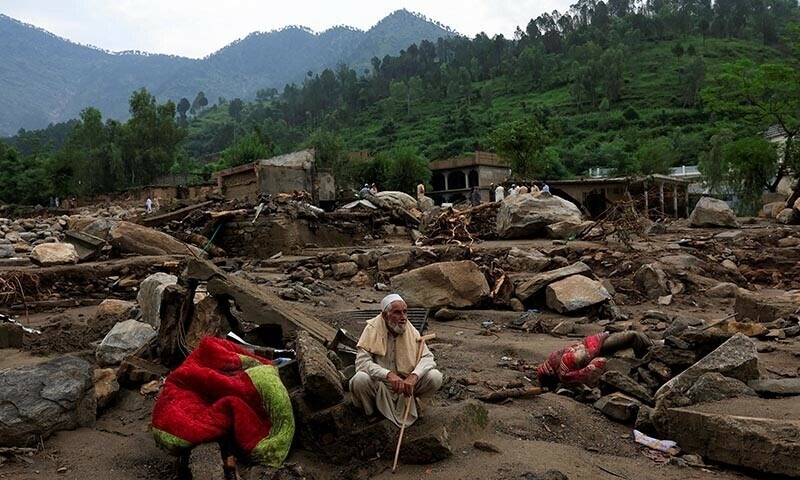By Imran Kamyana
As if the wounds of inflation, unemployment, terrorism, crime and state repression on the souls and bodies of the wretched people of this ill-fated country were not enough, the season of unusually intense rains and floods has returned once again. The ruthless harshness of nature and extreme weather have always been adversaries of humankind. Yet, over the past two decades or so, the catastrophic climatic events witnessed across the world cannot simply be blamed on nature itself, but rather on the reckless tampering with it that capitalism has pursued since its very inception. In Marx’s immortal words, “If money comes into the world with a congenital bloodstain on one cheek, capital comes dripping from head to toe, from every pore, with blood and filth.” From the very beginning, nature itself has been among the victims of the capital, alongside oppressed humanity. Driven by the logic of the market and the lust for profit, capitalism has treated nature not as a living entity bound to humanity by countless inseparable ties, but merely as a source of raw material and a dumping ground for industrial waste.
Since the end of the Second World War, the scale of environmental destruction has only intensified, as humanity’s technological and productive capacities have expanded at an ever-accelerating—indeed, exponential—rate. By itself, this is an immensely positive and progressive development, the product of humanity’s boundless collective labor and unyielding willpower. Yet under capitalism, these capacities are inevitably harnessed for exploitative, destructive and ruinous ends. That is why the centuries-long assault on the environment, having advanced with extraordinary speed in recent decades, is now revealing its consequences more starkly than ever. Rising global temperatures, raging wildfires, severe droughts in some regions and prolonged or intensified rains in others, smog and increasingly unpredictable weather events—all of these are the inevitable outcomes of this process. In the years ahead, this trajectory threatens to culminate in environmental, social and economic catastrophes so profound that the very survival of civilization and culture could be imperiled.
Pakistan ranks among the countries most severely affected by climate change. When humanity pours 41 billion tons of carbon dioxide into the environment every year, one can hardly expect any response other than the one the planet is now delivering. Yet the contribution of countries like ours to these greenhouse gas emissions—responsible for global warming—is negligible. This fact once again underlines the urgent need for an international and global struggle against capitalism. In recent years, even in Pakistan, scientific terms such as smog, flash floods, urban flooding and cloudburst have not only become common in the media but have entered the everyday vocabulary of ordinary people. This reflects the undeniable reality that climatic and environmental changes are unfolding, intensifying and increasingly shaping daily life.
The public is gradually becoming more aware of these facts. Experts point out, for instance, that incidents of cloudbursts—defined as rainfall exceeding 100 millimeters within less than an hour—have risen significantly in recent years. Such events generally occur in mountainous regions, triggered by the collision of warm and cold air currents. While not a new phenomenon, climate change—especially rising global temperatures that increase atmospheric moisture—has made it far more intense. These downpours can generate flash floods in a matter of minutes, leaving no time for protective measures. They also heighten the risks of landslides and widespread infrastructure destruction. In recent days, Pakistan’s northern regions have faced precisely such catastrophic conditions.
According to the BBC, more than 300 people have lost their lives in recent days due to heavy rains and landslides across Pakistan and the administered territories, with women and children making up a significant proportion of the victims. The actual death toll may be much higher than the officially reported figures. Nine deaths have been reported in Pakistan-administered Kashmir and five in Gilgit-Baltistan. In addition, five members of a rescue team were killed in a helicopter crash. However, the greatest loss of life and property has occurred in Khyber Pakhtunkhwa (KP), where districts such as Buner, Battagram, Mansehra and Bajaur have officially been declared disaster-stricken. The Meteorological Department has further warned that from 17 to 21 August, more rains are expected across the country. These could be not only intense but also bring fresh floods.
In underdeveloped countries, the problem is not only climate change, but also decaying infrastructure, haphazard construction and a lack of planning. One of the major causes of urban flooding is the dilapidated and inadequate drainage system. Construction is rampant—often illegal, but more commonly unsightly and unnecessary. In the race for quick and hefty profits, housing societies (real-estate schemes) are mushrooming one after another. Their development destroys valuable agricultural land and forests on the one hand, while on the other, there is no serious planning for sewage disposal, nor any consideration for the natural pathways of floodwaters.
This reality was witnessed just a few weeks ago in Islamabad, the capital itself, offering a glimpse of the conditions across the rest of the country. Even in the scenic valleys of Khyber Pakhtunkhwa, hotels and shops are routinely built right in the middle of, or dangerously close to, riverbeds and natural waterways. These practices frequently lead to accidents and the tragic loss of human lives. Institutions like Civil Defence exist here in name only. Rescue services, inadequate even in their best form, are confined largely to a few major cities. In most parts of the country, these agencies arrive hours—or even days—after disasters strike. The fault, of course, does not lie with the rescue workers themselves, who in many cases risk their own lives to help victims. The problem is that this crisis-ridden economy simply cannot allocate the resources needed to even think seriously about such matters. Whatever remains is further undermined by a corrupt and incompetent state bureaucracy.
The people of Bajaur (and other tribal districts of the former FATA), now devastated by the recent rains and floods, have for decades been crushed between the terrorism of fundamentalist armed groups—foremost among them the so-called Pakistani Taliban, or TTP—and the repeated military operations against them, particularly whenever these groups or some of their factions fall out of state favor. Countless ordinary, peace-loving people, including women and children, as well as the rank-and-file soldiers of the security forces—treated like pawns in a chess game—have lost their lives.
In recent weeks, the situation in Bajaur has once again taken a grave turn, and even the negotiations carried out through peace jirgas (councils of tribal elders) have proven fruitless. As a result, more than 55,000 people have once again been forced to flee their homes to save their lives.
Since 2001, twelve large-scale and officially declared military operations have been conducted in these Pashtun regions against the TTP, Al-Qaeda and other terrorist groups of the same ilk. In addition, there have been countless subsidiary operations and small-scale targeted actions. Yet the game that was first set in motion in 1979—at the behest of U.S. imperialism and its servile Gulf monarchs to crush the Afghan Saur Revolution—has today become far bloodier and more complex.
Nearly half a century ago, these tribal societies were undoubtedly backward. But the U.S.-sponsored “Dollar Jihad” in Afghanistan, carried out under the patronage of the Pakistani state, injected into their social life the poison of black money and religious fundamentalism. The uneven and combined development imposed on this region by belated capitalism only complicated this backwardness, giving it a more convoluted, toxic and savage character. Meanwhile, the ancient communal values of cooperation, tribal codes of respect and decorum, traditions of progressive literature, and cultural expressions that once nourished the human spirit—such as humor and folk music—have all been gravely wounded.
The return of Taliban rule in Afghanistan has produced outcomes entirely contrary to the expectations of the Pakistani state. The deeper involvement of regional powers such as China and India has further complicated the situation. The black economy associated with fundamentalist terrorism—and, over time, with the military’s counterterrorism operations as well—has also begun to acquire a logic of its own. This has led to constant splintering among terrorist organizations, the emergence of new groups, and state policies marked by contradictions and hypocrisy—adding yet more confusion and complexity. In this way, the vile machinery of imperialism has condemned social life in these regions to endless torments of terrorism, military operations and forced displacements, where the simple act of survival itself amounts to a struggle.
A further tragedy is that authentic and courageous mass movements such as the Pashtun Tahafuz Movement (PTM), which arose in opposition to this bloody game, have themselves been plagued by divisions, decline and a loss of direction—shaped by the ideological and political confusions or weaknesses of their leadership and the absence of a farsighted strategy. Traditional nationalist parties like the Awami National Party (ANP), meanwhile, have failed to adopt any unified or decisive position. This reflects, in essence, the inherent limitations and crisis of nationalism itself. Yet the conscious and vanguard layers of the oppressed and suffering classes, especially among the youth, will inevitably re-emerge, drawing lessons from these betrayals and retreats.
Nearly eight decades after “independence” from the British colonizers, this region has reached a state where accidents, tragedies and disasters have become routine. At the same time, the economic slaughter of tens of millions of workers continues largely unnoticed. The late Faiz Ahmad Faiz, the renowned Urdu communist poet, captures the anguish of these oppressed lands and peoples in his famous poem Intesab (Dedication), evoking the grim reality of suffering in these words:
A forest of yellowing leaves, that is my land
A gathering of suffering, that is my land…
It is an unending cycle of economic, cultural and environmental ruin, where any temporary pause or slight improvement is proclaimed as “progress.” Nor is this condition confined to Pakistan alone; virtually all societies with a history of colonial plunder and occupation—across South Asia and beyond—are afflicted by the same torments.
When people lack the ability to grasp the internal logic of events, or refuse to accept a rational and scientific explanation, they fall back on conspiracy theories. These typically exaggerate certain aspects, mix fabricated claims with facts, and then present them in ways that produce the desired conclusions. Such absurd notions regularly surface in connection with climate change, wars, pandemics and terrorism. Of course, minor and major conspiracies do exist in the world. But the reality is that the system governing this world is not run by conspiracy—it functions openly, under an order known as capitalism. And capitalism is not a conspiracy, but the outcome of a long historical process of social evolution.
Seen in this light, the root cause of the burning issues confronting the vast majority of humanity today becomes perfectly clear. The real “conspiracy” lies in the fact that the interests of a small minority, which monopolizes social wealth and the means of production, are bound up with the existence and survival of this system. They are prepared to go to any lengths to preserve it—even if millions perish from hunger, war and disease, or the very existence of humanity is threatened by environmental collapse. They will not voluntarily, or “gradually,” surrender their wealth and property. Nor can the profound crises of today be resolved by retreating to the so-called ‘good old days’ of the past, or by relying on reforms. The solution to these unrestrained rains and floods does not lie in dams. Terrorism cannot be eradicated by imperialist military operations. And liberation from imperialist and state oppression is impossible without dismantling the capitalist state itself.
All forms of resistance and struggle against oppression and exploitation must be united on this central basis, linking immediate demands with a far-reaching goal and vision. The guardians and enforcers of capitalism are not only wealthy but also powerful, cunning and ruthless; even if they wished, they could never be merciful. Only through a socialist revolution, by sweeping away this apathetic and merciless system, can this region and the wider world—now turned into a gathering of suffering—be transformed into a cradle of progress, love and joy. It is only in such a society that humanity will use its technological strength and capabilities not to mutilate nature and the environment, but to master them. And through that mastery, humankind will endow the world with such splendor and beauty as today cannot even be imagined.






